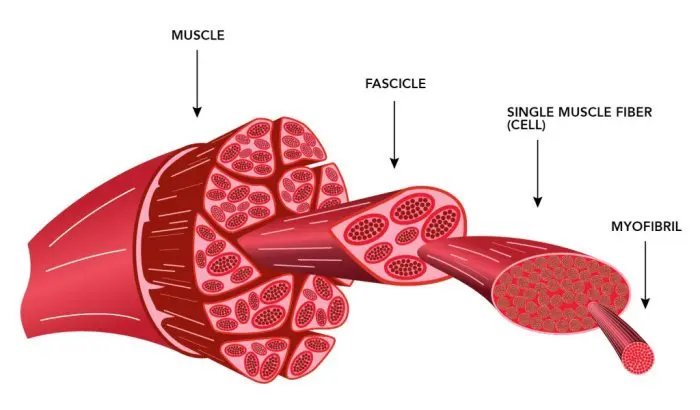A 5×5 workout structure is as simple (Not easy) as it gets and we don’t need to convince you of its effectiveness either.
The 5×5 exercise routine is perfect for those who are looking to gain lots of strength. And the size gains are, of course, a side effect (That’s a good thing).
So, you can use this program if you’ve hit a plateau or if you just need to change up your current routine. Many strength athletes and people, in general, do a 5×5 routine and it’s hard to go wrong with a progressive program which has been used for a long time!
What is a 5×5 Workout?
A 5×5 workout consists of doing 5 sets of 5 reps per exercise in an effort to really pack on the strength gains.

There are several different variations of the 5×5 program but you may have heard of StrongLifts 5×5 which is probably the most popular.
And the setup up for the workouts look like the following…
Level Up Your Fitness: Join our 💪 strong community in Fitness Volt Newsletter. Get daily inspiration, expert-backed workouts, nutrition tips, the latest in strength sports, and the support you need to reach your goals. Subscribe for free!
- Workout A: Squat, Bench Press, Barbell Row
- Workout B: Squat, Overhead Press, Deadlift
This is a great way to structure your 5×5 workouts and there isn’t an excessive amount of volume, so overtraining isn’t common if done correctly. With this structure, you’ll alternate workout A and B.
You won’t train two days in a row or do A and B on the same day either.
Now, this style of training allows you to train heavy, but you’re not maxing out and risking an injury. Most people would agree that this set and rep range is ideal and you’ll generally train 2-3 times per week.
But, 3 days per week is ideal.
Muscles Worked
The 5×5 program targets all muscle groups since each exercise is a compound, multi-joint movement. Barbell exercise variations will place a maximum load on each muscle group and they’ll also force other muscle to assist during each lift.
- Legs (Quadriceps, hamstrings, and calves)
- Back (Trapezius, rhomboids, Latissimus dorsi, and erector spinae)
- Chest (Pectoralis major and minor)
- Shoulders (Long, lateral, and posterior heads)
- Arms (Biceps and triceps)
- Core (Rectus abdominis and obliques)
Free Weights vs. Machines
The 5×5 program should be performed with free weights only. And that’s because they activate your core, utilize stabilizer muscles maximally, and allow you to progress way past a machine weight stack.
Machines are beneficial for certain instances but they’re not for an intense strength training program. Plus, the mechanics of a machine are not as beneficial for translating into sports and performance movements.
Benefits of 5×5 Workout
Strength gains
You’ll gain strength quickly because low reps are utilized for this purpose. And everyone knows that. But, you need progressive overload to stimulate growth and strength.
Adaptation occurs when we lift the same weight over and over again. But we must increase the resistance in small increments to force progression. (1)
And 5×5 actually recommends you increase the poundages each week continually!
Now, you’ll be training at 85% of your one-rep max, so you’ll force yourself to train with low reps. And low reps actually activate the fast-twitch muscle fibers, which are fast contracting but short on anaerobic energy output. (2)
But it’s a great way to train for power and explosiveness…
Since your training with a barbell you can increase weight in small increments and bilateral (affecting both sides) training produces the most resistance loads which are ideal for maximum strength increases.
Muscle growth
Research may be mixed on a lot of things but high-intensity training is no doubt effective while preventing overtraining.
But one study actually showed low reps (3-5) and high-intensity training to be more beneficial for muscle and strength gains, than higher volume (10-12 reps), moderate-intensity training. (3)
However, varied rep ranges are important and there are many more factors which go into muscle hypertrophy. (4)
Some people like to train a body part once per week and that’s fine. But, 5×5 may not be for you.
5×5 Workout Program
Since you’ll be alternating these workouts every other day, choose a schedule which works best for you to train (e.g., Monday, Wednesday, and Friday or Tuesday, Thursday, and Saturday).
Start light and train for a few weeks to get yourself used to the training frequency. This will prevent injury and condition your body to handle the workouts.
For the deadlift, you’ll only do 1 set of 5 reps (1×5) since squats are done 3 times per week. Doing 5×5 on the deadlift would be way too taxing and difficult.
After you’ve completed these three workouts, you’ll start again on Monday with workout B.
Rest between sets and weight loads
Make sure to rest at least 90 seconds between sets or more if needed to re-charge, since you’ll be training with 85% of your one-rep max.
Add 5 pounds to all lifts except for the deadlift which you’ll add 10 pounds to every exercise every week to keep progressing.
Beginner tips
Beginners should always start light and never jump into 5×5 without learning how to perform each exercise safely and effectively.
If you don’t usually perform these movements, start at around 50% of your one-rep max and slowly increase each week.
Warm-ups
Warming up properly before the main set is very important for injury prevention. It will also allow you to lift maximal loads. So, it’s important to slowly pyramid up in weight with two sets before getting into the heavy sets.
Level Up Your Fitness: Join our 💪 strong community in Fitness Volt Newsletter. Get daily inspiration, expert-backed workouts, nutrition tips, the latest in strength sports, and the support you need to reach your goals. Subscribe for free!
Start with 30 of your One-rep max and do a second set of 50-60% of your one-rep max.
The workout looks like the following…
Monday – Workout A
- Squat 5×5
- Bench Press 5×5
- Barbell Row 5×5
Wednesday – Workout B
- Squat 5×5
- Overhead Press 5×5
- Deadlift 1×5
Friday – Workout A
- Squat 5×5
- Bench Press 5×5
- Barbell Row 5×5
Simple right? It is. But, it won’t be easy and it will take some grit to get through the workouts. Growth requires stress and heavy training will cause a stimulus which will improve your overall performance.
Exercise Instructions
Squat
- Take a hip-width stance and unrack the barbell while keeping a straight back. Squat down slightly lower than parallel and push back up through your heels but do not lockout your knees at the top. Repeat.
Bench press
- Plant your feet firm on the ground and arch your back slightly. Grip the barbell with hands slightly wider than shoulder-width and tuck your elbows slightly toward your torso. Unrack the barbell and lower it to your sternum. Press back up and contract your chest muscles. Repeat.
Barbell row
- Grab the barbell with a shoulder-width grip, keep your back straight and bent over, and bends your knees slightly. Pull the barbell to your lower rib cage and contract your back muscles by retracting your shoulder blades. Lower the barbell so arms are extended and repeat.
Overhead shoulder press
- Sit upright and force your chest upward. Grip the barbell wider than shoulder-width and unrack the bar. Tuck your elbows in and lower it until your upper arms are parallel to the ground. Press upward but don’t lock out your elbows and repeat for reps.
Deadlift
- Bend over while keeping your back straight and grab the bar with hands slightly wider than shoulder-width. Push up with your midfoot and heels while thrusting your hips forward until you’re standing erect. Keep your shoulder blades pinned back.
Deloading
StrongLifts 5×5 recommends decreasing the weight by 10% if you’re unable to reach all 5 reps for an exercise after three workouts.
This will allow your body to recover and push you past the plateau. And then you’ll add weight as normal every workout which follows.
This is also good for mental progression and nervous system recovery.
What About Nutrition?
A good nutritional plan with complex carbs, fats, and protein is crucial to assist your efforts. Carbs and fats are a must for fueling your workouts unless you follow a keto lifestyle.
In that case, fats should be high so that your body can utilize fat stores for energy, while carbs remain very low. (5, 6, 7, 8)
Protein should be moderate to higher to rebuild the muscle tissue after an intense training session.
Make sure to drink plenty of water because hydration is essential for having optimal strength. At least a gallon and a half a day if training hard.
Sleep
Getting good sleep is essential for sufficient recovery. Muscle-building hormones are released during REM sleep and tissue repair happens. So, 7-9 hours per night is great but try to be consistent with your sleep schedule.
One study showed that performance aids like caffeine can actually allow you to train heavy despite not getting sufficient sleep. But, if you consume these aids, a lack of sleep will impair performance. (9)
How long does a 5×5 workout take to complete?
A 5×5 plan is no longer than your average intense workout routine. And it depends on how quickly you can get through it with enough rest in between sets to train with optimal strength levels.
Remember, strength training is different than hypertrophy training. To gain muscle, shorter rest periods are better. But strength training utilizes linger rest periods so you can recover to train heavy each set.
Is The Training Frequency Too Much?
The short answer is no…
But, there should be a period where you Deload, which is necessary to really allow your body to recover from the heavy training.
Many studies actually show higher training frequency to result in increased muscular strength. But, progressive volume in your workouts is also a factor in making strength gains; which can be achieved through training frequency. (10)
One study concluded that training three times per week was superior to one day per week. But, the participants in the study were untrained. (11)
However, getting results requires hard work and consistency. So, frequent workout sessions will no doubt give incredible gains, similar to how any other discipline requires countless hours of training to reach a high level of performance.
Ending Thoughts
A 5×5 workout routine is an amazing way to progress at a consistent rate and you can’t beat the simplicity.
A lot of people are intimidated by complex programs but this training protocol is anything but that!
All you need is a few multi-joint, compound exercises which are provided to you here and all it takes is 5×5. But, proper form is essential for longevity during this program and increasing the poundages in small increments every week will yield the results you’re looking for!
References
1. “Health Benefits of Resistance”. www.unm.edu. Retrieved 2021-01-16.
2. “How Many Reps Should You Be Doing?”. www.acefitness.org. Retrieved 2021-01-16.
3. Mangine, Gerald T; Hoffman, Jay R; Gonzalez, Adam M; Townsend, Jeremy R; Wells, Adam J; Jajtner, Adam R; Beyer, Kyle S; Boone, Carleigh H; Miramonti, Amelia A; Wang, Ran; LaMonica, Michael B (2015-08-13). “The effect of training volume and intensity on improvements in muscular strength and size in resistance-trained men”. Physiological Reports. 3 (8). doi:10.14814/phy2.12472. ISSN 2051-817X. PMC 4562558. PMID 26272733.
4. “Skeletal muscle hypertrophy”. www.unm.edu. Retrieved 2021-01-16.
5. Boston, 677 Huntington Avenue; Ma 02115 +1495‑1000 (2012-09-18). “Carbohydrates”. The Nutrition Source. Retrieved 2021-01-16.
6. Boston, 677 Huntington Avenue; Ma 02115 +1495‑1000 (2012-09-18). “Fats and Cholesterol”. The Nutrition Source. Retrieved 2021-01-16.
7. Boston, 677 Huntington Avenue; Ma 02115 +1495‑1000 (2012-09-18). “Protein”. The Nutrition Source. Retrieved 2021-01-16.
8. “What’s a Ketogenic Diet?”. WebMD. Retrieved 2021-01-16.
9. Knowles, Olivia E.; Drinkwater, Eric J.; Urwin, Charles S.; Lamon, Séverine; Aisbett, Brad (2018-09). “Inadequate sleep and muscle strength: Implications for resistance training”. Journal of Science and Medicine in Sport. 21 (9): 959–968. doi:10.1016/j.jsams.2018.01.012. ISSN 1878-1861. PMID 29422383.
10. Grgic, Jozo; Schoenfeld, Brad J.; Davies, Timothy B.; Lazinica, Bruno; Krieger, James W.; Pedisic, Zeljko (2018-05). “Effect of Resistance Training Frequency on Gains in Muscular Strength: A Systematic Review and Meta-Analysis”. Sports Medicine (Auckland, N.Z.). 48(5): 1207–1220. doi:10.1007/s40279-018-0872-x. ISSN 1179-2035. PMID 29470825.
11. Boivin, Alexander C. (2016). “The Effects of Resistance Training Frequency On Muscle Hypertrophy And Strength In Healthy Trained Individuals: Literature Review”. undefined. Retrieved 2021-01-16.








